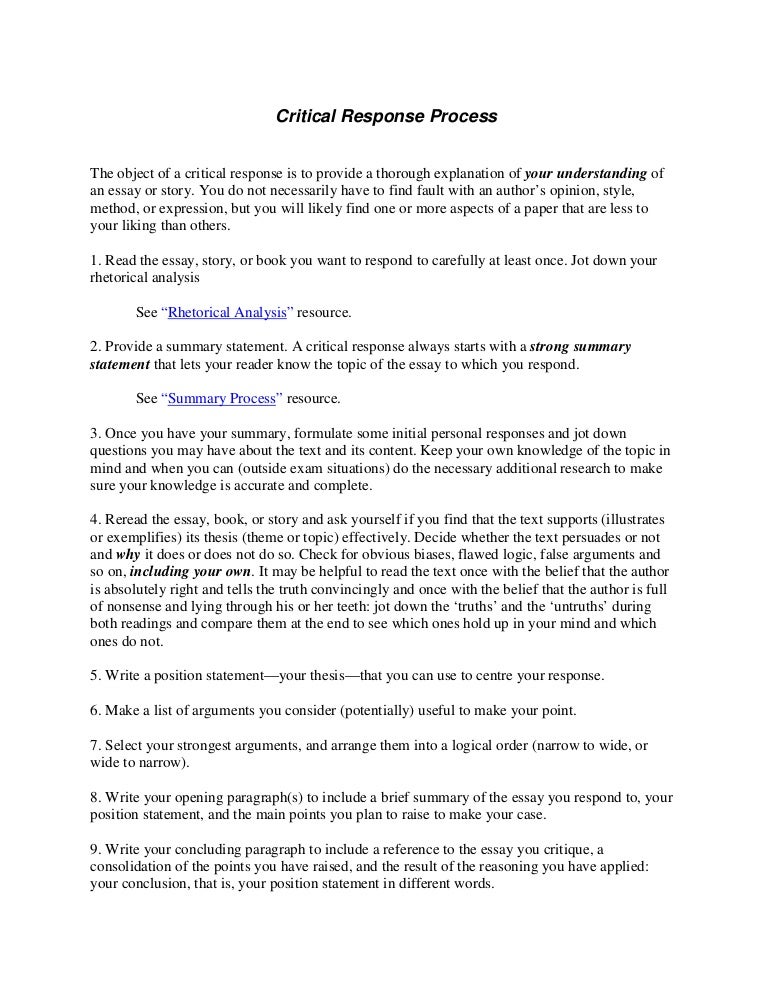
Critical Analytical Response Format This is a possible template for students to use when creating their critical analytical response. Critical Analytical Response to Texts Essay Format[1].pdf — PDF document, 75 kB ( bytes) Expanding an Outline Format Into a Critical Response Essay 1. Introduction The introductory paragraph in a critical response essay consists of two primary sections: a summary of 2. Body All body paragraphs have in a critical response essay four main elements: the writer’s idea, meaningful Summarising and paraphrasing are essential skills for academic writing and in particular, the critical review. To summarise means to reduce a text to its main points and its most important ideas. The length of your summary for a critical review should only be about one quarter to one third of the whole critical
SAMPLE RESPONSE PAPERS
Critical Response Process instills ways of thinking, communicating and being that enhance all kinds of critical response format interactions, from coaching to community dialogue, from artistic collaboration to family conversations. In use for over 25 years, Critical Response Process has been embraced by critical response format makers, educators, scientists, and theater companies, dance departments, orchestras, laboratories, conservatories, museums, universities, corporations, and kindergartens.
Role 3: Facilitator Initiates each step, keeps the process on track, and works to help the artist and responders use the process to frame useful questions and responses. Step 1. Step 2. Artist as Questioner The artist asks questions about the work. Step 3. Neutral Questions Responders ask neutral questions about the work, and the artist responds.
Questions are neutral when they do not have an opinion couched in them. This step is one of the most fundamental, challenging, and misunderstood steps of Critical Response Process. Step 4. Opinion Time Responders state opinions, given permission from the artist; the artist has the option to say no. Thank you so much for critical response format Critical Response Processand for communicating it to us with such care.
In Critical Response Process: a method for getting useful feedback on anything you make, from dance to dessert, authors Liz Lerman and John Borstel give a detailed introduction to the Process.
Beginning with its three roles and describing its four core steps, the book offers guidance for facilitators, practical examples, and useful variations. With a focus on actual works in progress — a dance, a script, a lecture, visual art work, even a cake — your training will highlight participation, conversation, and the flexibilty of the Process. You will leave with a firm grasp of procedures and tools to apply in your professional and daily life. Training programs are customized to suit the needs of our hosts and may last from two hours to four days.
The Critical Response Process team has trained arts faculty, orchestra members, museum docents, critical response format, acting companies, social science researchers, and nonprofit boards, critical response format, as well as students and makers in almost every artistic discipline.
Sign up for email updates and prompts related to Critical Response Process. Critical Response Process. Through the supportive structure of its four core steps, Critical Response Process combines the power of questions with the focus and challenge of informed dialogue.
The Process offers makers an active role in the critique of their own work. It gives makers a way to rehearse the connections they seek when art meets it audience or a product meets its purpose. Offers a work-in-progress for review and feels prepared to question that work in a dialogue with other people. Role 2: Responder. Role 3: Facilitator. Initiates each step, critical response format, keeps the process on track, critical response format, and works to help the artist and responders use the process to frame useful questions and responses.
Statements of Meaning. Artist as Questioner. The artist asks questions about the work. Neutral Questions. Responders ask neutral questions about the work, and the artist responds. Opinion Time. Responders state opinions, given permission from the artist; the artist has the option to say no.
Purchase the book. Critical Response Process deepens dialogue between critical response format and audiences and enhances learning between teachers and students. Book a workshop. The Process empowers artists and invests responders with real responsibility as audience members.
Nicola, Artistic Director, New York Theatre Workshop. Invest in Critical Response Process. Critical Response Process Certification. We will never ever ever sell or share your name, critical response format.
Critical Analysis Essay [Example, Outline, Tips]
, time: 8:44Critical Response Essay: Purpose & Examples - DSST Class [ Video] | blogger.com
8/2/ · How to Write Critical Response Conclusion. The best way to conclude your essay is to restate your thesis statement in different phrasing. Summarize all of your findings and repeat your opinion on the subject. A one- or two-paragraph conclusion is usually enough if not requested more. We’ve also prepared some critical response essay topics for you Critical Analytical Response Format This is a possible template for students to use when creating their critical analytical response. Critical Analytical Response to Texts Essay Format[1].pdf — PDF document, 75 kB ( bytes) Summarising and paraphrasing are essential skills for academic writing and in particular, the critical review. To summarise means to reduce a text to its main points and its most important ideas. The length of your summary for a critical review should only be about one quarter to one third of the whole critical

No comments:
Post a Comment